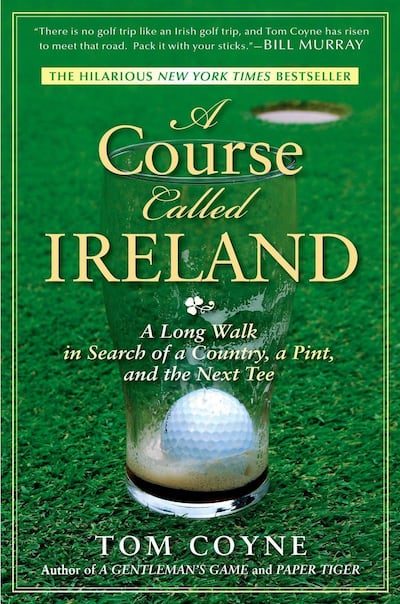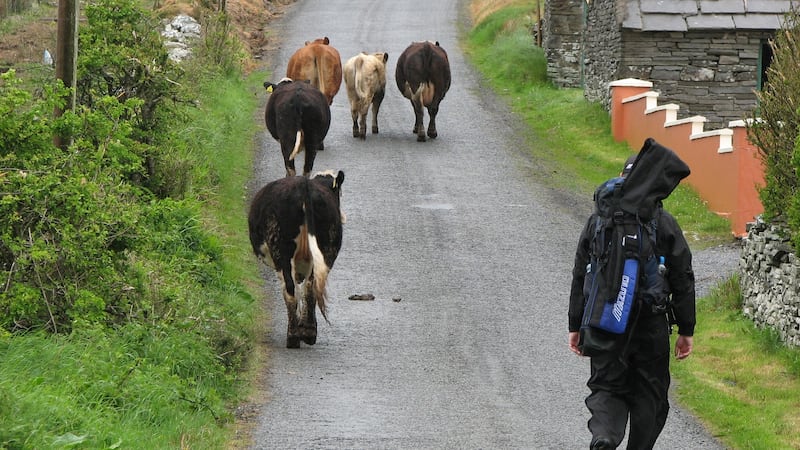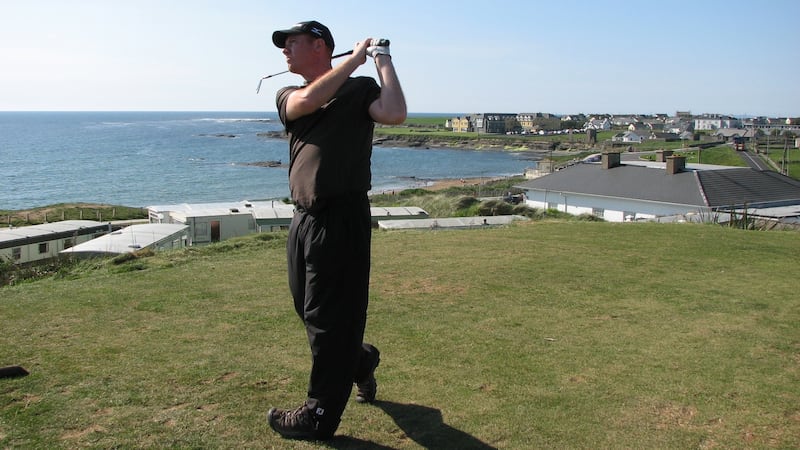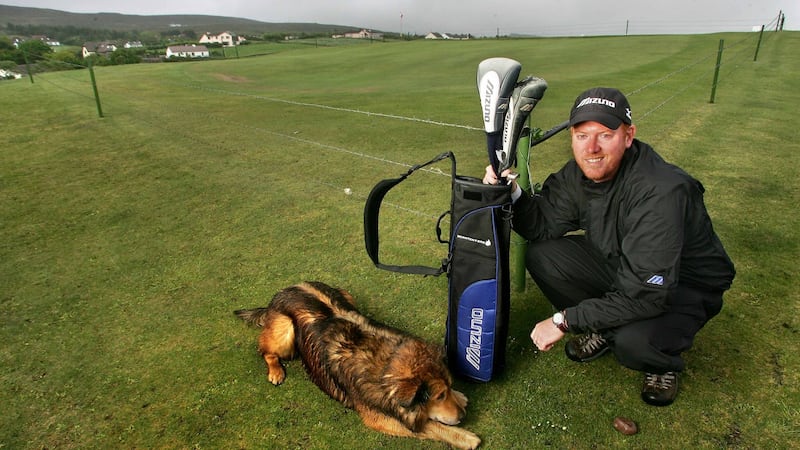At first it was a crazy idea. A trip from the United States to Ireland to play every links course on the island - with a few parkland along the way - and, to top it all off, doing it all on foot.
And no, not just the golf on foot. All of it on foot. The full coastline of the island on just two legs.
Such an idea would be beyond the realms of possibility for anyone in Ireland, not least a married man living in Philadelphia without even the appropriate shoes to so much as consider walking over 3,000 kilometres along roads, beaches, bogs and fields.
So, fast forward a few months to May 2007 and Tom Coyne is standing on the first tee at Kilkee Golf Club in Co Clare with his clubs and a few other slightly less important possessions in the bag on his back - a four-month long adventure and a 990-hole, 1,967,680-yard, Par 3,895 golf course ahead of him.
The idea, put simply, was to walk the entire coastline of the island of Ireland and play every golf hole along the way, making up what would eventually become A Course Called Ireland.

In the bag on his back was a binder which included maps, 103 room reservations and over 40 tee times. By the end of the trip he had hit 4,531 shots, lost 129 balls, visited 196 pubs and had the makings of a New York Times bestseller which, 14 years later, is still selling and has become something of a bible for American golfers planning trips to Ireland.
“Thinking back on it it’s hard to believe that was me,” says Coyne. “I see the pictures and there’s video to prove that I did it and there’s a book here on my bookshelf but it feels like an entirely different life.
“Now I have two daughters, I’m a professor at university, I’ve gone on to do other golf adventures and other big ambitious golf trips but doing it that way, doing it on foot and doing those miles . . . I can’t imagine someone saying today you should go and do this and me saying ‘yeah, that sounds like a good idea’.
"At that point in my life I didn't take into account the physical difficulty. I'm a little older so I'd say could my body actually do that? But I didn't take into account, either, the danger factor of walking, say, what's supposed to be a two-lane road in Donegal but it's about half of a lane with my whole life on my back and going around a tight turn on the edge of the road with no shoulder . . . that's pretty crazy. But at that point of my life it was fun. It was this great adventure.
“Coming up with this idea I was looking at a golf map of Ireland trying to plan a trip just with my friends and I was thinking where should we go - should we try the southwest? Should we go up to Donegal? Should we try the North? But the island is just ringed with these golf courses and started to look like one big golf course in a silly way on this map on the wall and I thought ‘well what if you just played them all?’
“And I thought to ask a publisher to let me do that is just sort of self-indulgent. What’s the hook? And the hook was that in Ireland you walk, you don’t really take buggies - maybe more people do now but back then nobody would - so I’m going to literally walk the entirety of the ‘golf course’.
“So that idea was something of a gag or a gimmick to make the book different and to help sell it to a publisher but it really became such an essential part of the story - not just because it lent that danger or drama of whether I could actually walk around the country on foot - but because it made me take in Ireland at a different pace.”

There’s nothing like a visitor’s perspective to make you take a step back and evaluate what you have on your doorstep and that’s what Coyne’s book does for an Irish reader. It’s always easy to forget just how unique links golf is and how Ireland is, for many Americans, towards the very top of the bucket list.
What’s more, because Coyne walks the entire coastline, he stops in plenty of off-the-beaten-track towns which the American tour buses wouldn’t visit. Places that aren’t crammed with gift shops and hotels and pubs that are filled with actual real-life locals.
"I go to a place like Carne, in Belmullet, and I feel, like, just total happiness and peace and a lot of it is to do with the people I know I'm going to see - they're friends and not a cross word is going to be shared at all for the time I'm in Ireland and that feels pretty good because there's a lot of cross words going on over here, if you haven't noticed, and there's plenty of grudges in Ireland for sure too but I'm not part of them so it's just a really peaceful place.
“I love the people, I love the pace of life, I love the sense of humour and I love the snacks and the candy bars too.”
Although the novelty of the full Irish breakfast wore off after a while when it was on offer every single morning in the B&Bs along the way, the hospitality and the friendly welcomes in the 196 pubs Coyne visits around the island is a constant throughout the book. It’s a familiar lament among Irish people abroad that other countries just don’t do pubs like we do at home and, as much as it sounds like a worn-out cliché, reading the tales from A Course Called Ireland (coupled with a pining for a stool in any pub at the moment) makes you realise that it’s a cliché which rings true.
The Beach Bar at Aughris Head, the Stores Pub in Portsalon and the Old Commercial Bar in Ardglass get Coyne's top billing in the pub stakes but there are plenty of others which warrant some inches on the pages of the book including a conversation in Matt Molloy's of Westport where a Meathman by the name of Séamus listed all of the reasons why he thought golf was, essentially, about the worst thing on the planet. Needless to say, that was never going to be a lasting friendship.
Coyne's Irish roots are very similar to those of US president Joe Biden in that his great-grandparents left Co Mayo and settled in Scranton, Pennsylvania and, after first visiting the country as a child and then again with his father on a golf trip at the age of 19, Coyne says he immediately felt like he fit into the Irish way of life while the rugged linksland which contrasts so acutely with the manicured lush parkland courses in much of America was the icing on the cake.
The other main contrast, of course, is that even the very best courses on this island are accessible to visitors. In the States the odds of walking on the moon wouldn't be too dissimilar to the odds of even stepping through the gates at the likes of Augusta National, Pine Valley, Oakmont, Merion, Medinah or countless other private clubs but get on the phone to Ballybunion, Lahinch, Portrush or the Old Head and you'll get a tee time no problem. Particularly this year when the chances of any international golf visitors landing in Ireland are looking slimmer and slimmer by the day.
It’s this contrast which makes golf on this side of the Atlantic so appealing to Coyne and to lots of Americans.

“In Ireland, talk about the welcome you’re going to feel, that’s tremendously appealing and it’s a drum that I continue to bang over here is to say ‘look how they do it’. There’s things you take when you travel, you look at any culture or country and you say ‘they would be better if they did it like we did’ or ‘we’d be better off doing it like they do’. I think, golf-wise, the idea to have a visitor green fee or have visitor tee times at private clubs means yeah, the club can be exclusive but, for the course itself, there’s no reason to put a lock and chain on it.
"That's fine if Ballybunion or Lahinch want it, that to be a member it's a certain thing or in Scotland to be a member of the Royal and Ancient is a certain thing but I can still play the (St Andrews) Old Course and I can still go play Lahinch and Ballybunion and that's just wonderful - why not share the golf course and let the club and course be separate things?
“I just think that makes sense, it’s good for the game, it helps members by underwriting your dues by bringing money into clubs.”
Before A Course Called Ireland, Coyne had written a golf novel called A Gentleman’s Game as well as Paper Tiger which saw him dedicate 546 days to playing golf in a bid to make it from a handicap of 14 to the professional game. A Course Called Ireland was different. As he says himself, “it sold circles around both of the other books,” and has become a mainstay for the thousands of American golfers who land in Ireland every year looking for the same buzz of playing links golf, the same pints of Guinness and the same feeling Coyne felt on his journey.
With a publishing deal already in the bag before he arrived in Ireland, there was extra motivation there for Coyne to complete his trip but still, he says, there were moments when the thoughts of jumping on a bus or just stopping altogether did come into his head.
“Felt like it? Yeah. Fantasised about it on the road? Probably. There were moments where I entertained the fantasy but I was all in, I was fully committed not just even as a walker or a golfer or a tourist, but I was also committed as an author. I’d taken the advance from my publisher - I had to finish the book.
“If I didn’t have that motivation and it was something I was just doing for the craic, as they say, or just to tell my friends about it then no, I wouldn’t have made it a week but I’d made this commitment to a publisher and to my family because we planned out our whole life around this, although we didn’t have kids then. But there were all these other reasons to keep doing it and, at the end of the day, those kept me going. You’re talking about your career and you want to write this book so that’ll keep you going.”

A Course Called Scotland would follow in 2018 and A Course Called America - in which Coyne plays in all 50 states and manages to find his way onto some of the most exclusive courses in the world - comes out in May of this year but he says that 2007 trip to Ireland, as wet, windy and painful as it was at times, was the springboard.
“I had a small audience in golf before A Course Called Ireland. It surprised everyone with how it sold and how it continues to sell and it allowed me do these other books and it really gave me a career that I never really anticipated. I’m so grateful not just to the book but to golf in Ireland and the people for giving me these stories because I just collected them. The stories were there, I just had to find them.”












